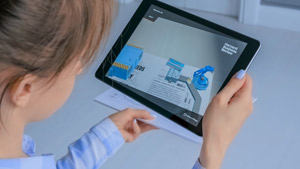
In my last post, Augmented Reality, Part 1: Ideas for Extending Print’s Value,
we discussed the importance of leveraging the power of mobile devices by incorporating augmented reality (AR) with print. We also discussed how AR works and creative ideas for print. In this post, we’ll continue the discussion with how to sell
AR, what kinds of questions you should be asking, and the pricing conversation.
Selling AR
Selling AR requires a more in-depth conversation with the client, understanding their business needs, and getting creative in extending the trust and value of print. There are thousands of examples of AR in action; just do a quick search on YouTube
to get inspiration and ideas.
To sell, you have to great creative and lead with what’s most important to the client. For example, benefits that an AR solution can help provide are increased sales, brand recognition (which increases
sales), and more in-depth information (which increases sales). With an AR solution, you must uncover this information by having deep conversations about your client’s business.
Here are some questions to consider when having the AR
discussion with the client:
• What kind of — and how good — is the client’s data?
• What is the goal the client wants to achieve?
• What kind of budget does the client have to work with?
• Is this budget realistic based on the amount of time needed to develop the AR solution?
•
Is the deadline realistic? Remember, AR requires more development time than just putting ink or toner on paper!
• Who will be responsible for design and creative development? With AR and print,
the creative or designer will be more involved with production than a regular print job.
Pricing AR
When it comes to the pricing conversation, the range is going to depend on the economic area that the client lives. Some clients won’t blink at a $20,000 deployment; others might tell you that they only have $3,000 to work with. Yes, $3,000 and
$20,000 is a large spread, but the reality is even at $3,000, you can still come up with simple, innovative ways to add value with AR. Either way, the depth of conversation required for creating an AR solution should not be given away for free.
Your time and thought process are valuable. You’ve sat down with the client and developed a creative, innovative, AR solution, and you’re delivering this technology so that your client can deeply communicate with its customer base.
It’s the connection, interaction, and analytics that have real power and value.
If there’s one thing that AR shouldn’t be, it’s boring. A boring experience is far worse than no experience at all. Have you ever downloaded
an app promising something cool or useful, and it just links to a webpage? What a letdown! AR experiences should be compelling and engaging, and there needs to be a magic moment associated with it. It needs to be clear, intuitive, and easy to use
for the consumer. The very best AR experiences extend the value of the printed page for your clients while delivering a seamless combination of the real world, print, and digital delivery.

Joe Marin is senior VP, education and training at PRINTING United Alliance, through which he pursues his passion helping people learn, advance, and grow. He has spent the majority of his career in the printing industry and is one of the leading voices on digital technologies, speaking at major industry trade shows and conferences on topics related to succeeding in a digital print environment.